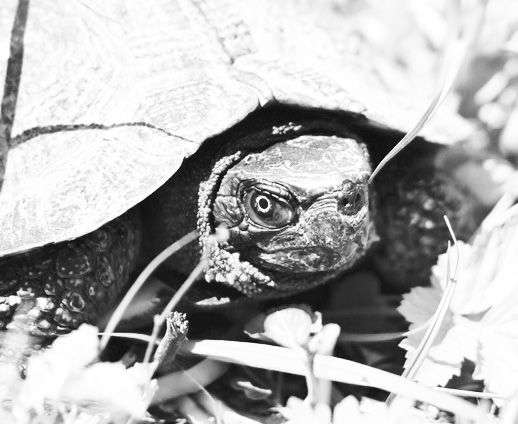
Photo by Joan Heffernan
Wood Turtle
Our eyes met on the trail where many great relationships ignite. I had just headed down the hill and came face to face with a pretty rare reptile in these parts, a wood turtle. A mostly terrestrial turtle with a dark brown shell with subtle chiseled patterns and a yellow plastron or bottom shell, he had orange markings on his head and legs and was almost nine inches long. Needless to say, he was quite a specimen. And, before I knew it, I was scrolling back to the last wood turtle I had seen on the trail a few miles up the stream bed a decade or so ago. Then I had a eureka moment figuring this was the same turtle. Wood turtles are known to cover quite a bit of ground for terrestrial terrapins, and, if I was right, he was about five miles south of where we last were face to face. By now Clapton’s, “Hello Old Friend” was playing on loop in my head, and I needed a box of tissues to contain my emotions at this serendipitous moment.
Wood turtles have complex habitat needs and never stray too far from a steam or river bed. From spring until fall, they spend their days on land eating slugs, worms, insects, berries and carrion. When the days get short and cold, they retreat into the stream and hibernate under the water. In the spring or summer the female lays four to 12 eggs, usually in sandy soil. These baby turtles will continue the cycle, and if things are good in their turtle world, they may live to be 40 or 60 years old. Sadly, habitat fragmentation and destruction have made it difficult for the wood turtle to thrive in our state.
Once I got a hold of myself, I started to contemplate how challenging it must be for the wood turtle to find a mate and to perpetuate this cycle. But then I remembered another neat adaptation of turtles, the ability to store sperm. As backed up by the Journal of Heredity volume 92, wood turtles can store sperm for up to four years and at least half of their clutches have multiple paternity. Boy, it makes conventional human procreation seem like a snooze fest.
Now I am hunkered down, preparing for another decade or so before I get a glimpse of my old turtle friend again. In the meantime, someone who knows my love for turtles arrived on my doorstep one day with something in his hands wrapped in linen cloth. I unwrapped the bundle to discover a turtle shell that he had found in an old foundation. He had polished it, and it now sits in a place of honor in my house. I made a little scroll of paper which lives in the shell outlining the occasion, including the name of the friend who stopped to share it, in case someday I cannot remember. This is important stuff and Clapton’s lyrics continue to loop. “Hello old friend, It’s really good to see you once again. I’m sure the distance wouldn’t be too far if I got out and walked to where you are.” I need to get walking, pronto.